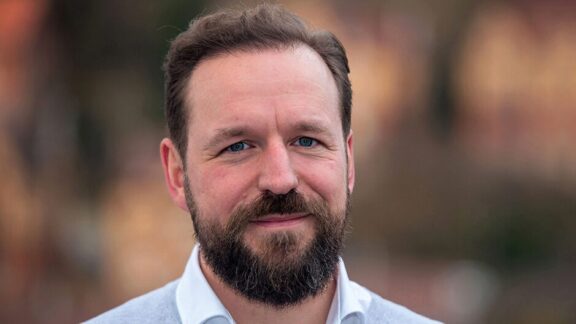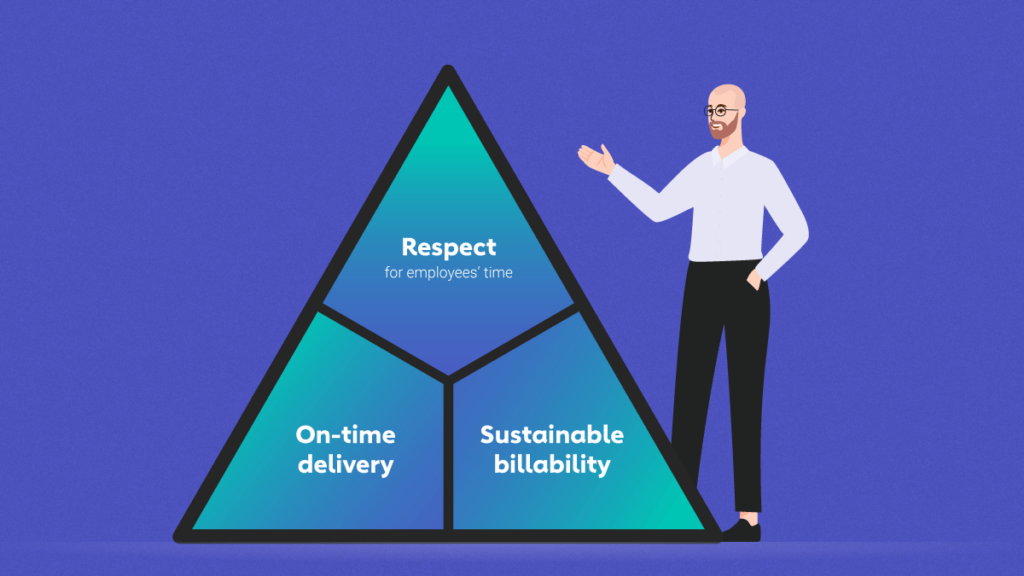Running a solutions company is different from managing a single project.
In a single project, a project manager must balance cost, time and scope. By maintaining any one dimension with the desired quality or value, the other dimensions may be negatively affected. This concept is known as the iron triangle of project management.
But you’re running a company, not a project! As a provider of complex technical solutions, what are the different factors you have to balance? And is it actually a given that any one dimension will suffer when you optimize another? We don’t think so!
We believe the three factors are:
- Respect for employees’ time – responsible planning that gives employees enough time to really focus.
- On-time delivery – reliably providing customers with a working solution.
- Sustainable billability – high average billability across the year.
We’ve borrowed and repurposed the iron triangle model to represent our factors for successful solution providers.
Why Are These Important?
Respect for Employees’ Time
It’s management’s job to create the best possible economic outcome for the company based on available resources. This means that you have to make the best use of your people’s time.
Since you provide complex technical solutions, this means that you have to give your employees the time they need to properly focus on their work (and make sure you earn money with it, too).
When you don’t give your employees enough time, they end up with too much on their plates. Then it simply isn’t possible to punctually deliver high quality products, endangering future revenue. If teams are trying their best to accomplish the impossible, they quickly become disengaged and demotivated. Low levels of satisfaction lead to higher turnover rates, resulting in lost revenue potential, hiring and training costs.
On-Time Delivery
As a service provider, you depend on continuously delivering value to your customers. When deadlines are consistently met, your customers can confidently rely on you. This earns you repeat business and great references for new customers. Plus, you can leverage past experiences and develop your offers into standardized product components.
Of course, you need people with the right skills to get all this work done. That means you have to ensure your teams have enough time to work together on solutions for your customers.
Sustainable Billability
Most solution providers earn their money through billable hours. That’s why it’s paramount to ensure your experts are available to work on as many paid assignments as possible. But your experts are only human, and they can’t be available all the time! So the key challenge is keeping billability high on average throughout the year while reliably meeting deadlines and without overloading your teams.
Besides customer projects, another source of income might be licensing revenue from productized components. However, doing this means your resources have to work on internal projects instead of customer projects.
Lastly, even if you know your teams are fully booked, you wouldn’t turn down a single customer order, would you? Instead, you might have to employ contractors, reducing your profit. Wouldn’t it be great to avoid that, and to get the billable hours in for your own staff?

Can You Really Achieve All Three?
It’s a hefty goal, but we know it’s possible! Unlike the iron triangle of project management, which is a zero-sum game, our iron triangle drives to create a self-reinforcing system.
The common thread tying everything together? The people! Addressing the top point of the triangle (respect for employees’ time) will immediately have a positive impact on the bottom two points. Successful companies will put people first; only then do on-time delivery and maximized billability become much more achievable. In the end, you’ll find your company in perfect equilibrium with consistently high values for all three dimensions.
Read a case study about how our customer, Sovanta, manages their teams and reliably delivers IT customer projects.
Okay, So How Do You Do It?
Some Common (But Flawed) Strategies
You certainly aren’t the first organization to face this optimization challenge. Two of the most common approaches are establishing goals and creating detailed plans, but these don’t always work out as expected.
Creating Clear Team and Individual Billability Goals
In this situation, you have a billability goal that optimizes for the short term on your individual team. But this only optimizes for billability, not for customer satisfaction. And since it’s not part of the goal, respect for employees’ time isn’t considered either. Additionally, because you’re focusing on your own team, you aren’t supporting other teams when you have the capacity to help.
Creating Detailed Project Plans
For this approach, you try to foresee all possible tasks for the entire project duration. This is not only tedious, but it’s also a fool’s errand. You don’t know exactly what you’ll be working on, so you end up making things up and wasting time because the plans aren’t accurate. At most, only the plans for the next few weeks are reliable.
Our Solution
What you really need is a flexible solution that works across all teams and projects. This way, you can look at the big picture of the entire organization.
This is why we believe collective intelligence and foresight to be crucial.
Collective Intelligence
Transparently working together across teams makes your entire organization more efficient. Support other teams when you have the extra capacity and receive help when you need it. This way, your organization can create the best outcomes for customers and maximize billable hours – all without overloading your employees.
Foresight
Plan ahead with rough forecasts or whatever data you have available. Use “what-if” scenario modelling to adjust plans or test alternatives so you don’t get stuck with unrealistic or outdated plans. Being proactive allows you to be confident that you’re prepared for upcoming projects.
The perfect way to do this is by using a resource-centric planning tool like Meisterplan. Easily stay on top of plans by efficiently managing your resources and creating clear expectations of what’s actually feasible.
Meisterplan is Trusted by Leading IT Solution Companies
Read Next

What If Our Plans Actually Worked?



